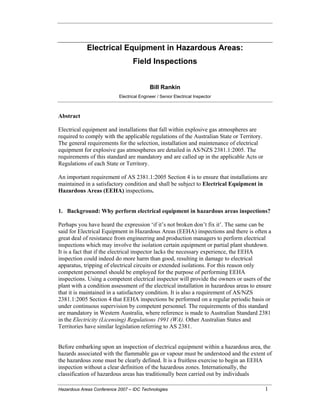Excitement About Roar Solutions
Excitement About Roar Solutions
Blog Article
Roar Solutions for Beginners
Table of ContentsThe smart Trick of Roar Solutions That Nobody is DiscussingEverything about Roar SolutionsThe Greatest Guide To Roar Solutions
In order to secure installments from a possible explosion a method of analysing and identifying a possibly harmful location is required. The objective of this is to make certain the proper choice and installment of tools to ultimately protect against a surge and to ensure safety of life.
(https://dc-washington.cataloxy.us/firms/training.roarsolution.com.au.htm)
No devices should be mounted where the surface temperature level of the equipment is higher than the ignition temperature level of the given risk. Below are some typical dirt hazardous and their minimum ignition temperature. Coal Dust 380C 225C Polythene 420C (thaws) Methyl Cellulose 420C 320C Starch 460C 435C Flour 490C 340C Sugar 490C 460C Grain Dust 510C 300C Phenolic Material 530C > 450C Aluminium 590C > 450C PVC 700C > 450C Residue 810C 570C The likelihood of the danger being present in a concentration high adequate to create an ignition will differ from area to location.
In order to categorize this risk an installation is separated right into areas of danger relying on the amount of time the dangerous exists. These locations are described as Zones. For gases and vapours and dusts and fibers there are 3 zones. Area 0 Area 20 A hazardous environment is extremely likely to be existing and may exist for long periods of time (> 1000 hours annually) and even continuously Area 1 Area 21 A dangerous atmosphere is possible however unlikely to be existing for lengthy durations of time (> 10 450 C [842 F] A category of T6 indicates the minimal ignition temperature is > 85 C [185 F] Hazardous location electrical devices maybe made for use in higher ambient temperatures. This would certainly indicated on the rating plate e.g. EExe II C T3 Ta + 60C( This indicates at 60C ambient T3 will certainly not be exceeded) T1 T1, T2, T3, T4, T5, T6 T2 T2, T3, T4, T5, T6 T3 T3, T4, T5, T6 T4 T4, T5, T6 T5 T5, T6 T6 T6 A T Class ranking of T1 means the maximum surface area temperature level produced by the instrument at 40 C is 450 C. Assuming the linked T Class and Temperature level rating for the tools are ideal for the area, you can constantly make use of a tool with a much more strict Division rating than required for the area. There isn't a clear response to this concern unfortunately. It really does rely on the kind of devices and what repair services require to be executed. Devices with certain examination procedures that can't be executed in the area in order to achieve/maintain 3rd party score. Must return to the manufacturing facility if it is before the tools's service. Area Repair Service By Authorised Worker: Complex screening may not be called for nevertheless specific procedures might require to be followed in order for the tools to preserve its third celebration rating. Authorised employees should be utilized to do the work appropriately Repair work must be a like for like replacement. New part need to be considered as a straight substitute calling for no unique testing of the equipment after the repair work is total. Each tool with a hazardous ranking must be reviewed individually. These are laid out at a high degree listed below, but also for more in-depth details, please refer directly to the guidelines.
The 9-Minute Rule for Roar Solutions
The devices register is a detailed data source of tools documents that includes a minimum collection of fields to determine each thing's area, technical parameters, Ex-spouse category, age, and ecological data. The ratio of Thorough to Close assessments will certainly be figured out by the Equipment Danger, which is evaluated based on ignition risk (the possibility of a resource of ignition versus the likelihood of a combustible ambience )and the dangerous location category
( Zone 0, 1, or 2). Executing a robust Risk-Based Examination( RBI )approach is critical for guaranteeing conformity and safety in managing Electric Tools in Hazardous Areas( EEHA).
Roar Solutions Can Be Fun For Everyone

In regards to eruptive threat, a dangerous area is an environment in which an eruptive atmosphere exists (or may be anticipated to be existing) in amounts that need special preventative measures for the building and construction, setup and usage of devices. electrical refresher course. In this short article we explore the difficulties dealt with in the workplace, the risk control procedures, and the required expertises to work safely
These substances can, in specific problems, create eruptive ambiences and these can have significant and tragic consequences. Most of us are acquainted with the fire triangular eliminate any type of one of the 3 components and the fire can not happen, but what does this mean in the context of dangerous areas?
In most circumstances, we can do little about the degrees of oxygen in the air, read the full info here yet we can have significant influence on sources of ignition, for instance electric devices. Hazardous locations are recorded on the unsafe location classification illustration and are identified on-site by the triangular "EX" sign. Here, amongst various other key info, zones are divided right into three types depending upon the threat, the probability and period that an explosive ambience will certainly exist; Area 0 or 20 is considered the most unsafe and Zone 2 or 22 is regarded the least.
Report this page